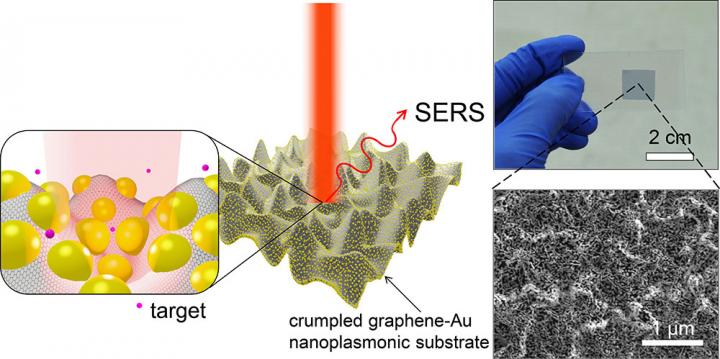Novel 'crumpling' of hybrid nanostructures increases SERS sensitivity

Illustration of SERS enhancement from a crumpled graphene-Au nanoparticles hybrid structure. Raman spectrum is enhanced the most when the target molecule is situated at the center of Au nanoparticles in valley of crumpled graphene as depicted in inset. Credit: University of Illinois
“I believe that this work will benefit researchers in the area of surface plasmonics by providing a new strategy/design for enhancing the surface enhanced Raman spectroscopy (SERS) detection limit,” explained SungWoo Nam, an assistant professor of mechanical science and engineering at Illinois.
“This mechanical self-assembly strategy will enable a new class of 3D crumpled graphene?gold (Au) nanostructures. The enhanced limit of detection will allow biomedical and environment monitoring of important molecules at high sensitivity by SERS.”
SERS substrates are used to analyze the composition of a mixture at the nanoscale for environmental analysis, pharmaceuticals, material sciences, art and archeological research, forensic science, drug detection, food quality analysis, and single cell detection. Using a combination of gold and silver nanoparticles and Raman-active dyes, SERS substrates also can target specific DNA and RNA sequences.
“This work demonstrates the unique capability of micro-to-nanoscale topographies of the crumpled graphene-Au nanoparticles–higher density, three-dimensional optically active materials–that are further enhanced by the formation of hot spots, bringing the nanoparticles closer,” explained Juyoung Leem, a graduate student and first author of the study, “Mechanically Self-Assembled, Three-Dimensional Graphene?
Gold Hybrid Nanostructures for Advanced Nanoplasmonic Sensors,” published in Nano Letters. “We achieve a 3D crumpled graphene?Au hybrid structure by the delamination and buckling of graphene on a thermally activated, shrinking polymer substrate. This process enables precise control and optimization of the size and spacing of integrated Au nanoparticles on crumpled graphene for higher SERS enhancement.”
According to Nam, the 3D crumpled graphene?Au nanostructure exhibits at least one order of magnitude higher SERS detection sensitivity than that of conventional, flat graphene?Au nanoparticles. The hybrid structure is further adapted to arbitrary curvilinear structures for advanced, in situ, nonconventional, nanoplasmonic sensing applications.
“One of the key advantages of our platform is its ability to shrink and adapt to complex 3D surfaces, a function that has not been previously demonstrated,” Nam stated. An earlier study by Nam's research group was the first to demonstrate graphene integration onto a variety of different microstructured geometries, including pyramids, pillars, domes, inverted pyramids, and the 3D integration of gold nanoparticle/graphene hybrid structures.
###
In addition to Leem and Nam, the study's co-authors include post-doctoral researcher Pilgyu Kang and graduate student Michael Cai Wang in the Department of Mechanical Sciences and Engineering. Experiments were carried out in part in the Frederick Seitz Materials Research Laboratory, the Micro and Nano Technology Laboratory, and the Beckman Institute Imaging Technology Group at Illinois.
Media Contact
All latest news from the category: Materials Sciences
Materials management deals with the research, development, manufacturing and processing of raw and industrial materials. Key aspects here are biological and medical issues, which play an increasingly important role in this field.
innovations-report offers in-depth articles related to the development and application of materials and the structure and properties of new materials.
Newest articles

Bringing bio-inspired robots to life
Nebraska researcher Eric Markvicka gets NSF CAREER Award to pursue manufacture of novel materials for soft robotics and stretchable electronics. Engineers are increasingly eager to develop robots that mimic the…

Bella moths use poison to attract mates
Scientists are closer to finding out how. Pyrrolizidine alkaloids are as bitter and toxic as they are hard to pronounce. They’re produced by several different types of plants and are…

AI tool creates ‘synthetic’ images of cells
…for enhanced microscopy analysis. Observing individual cells through microscopes can reveal a range of important cell biological phenomena that frequently play a role in human diseases, but the process of…





















